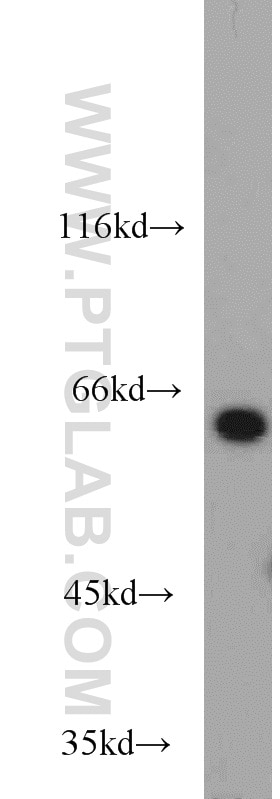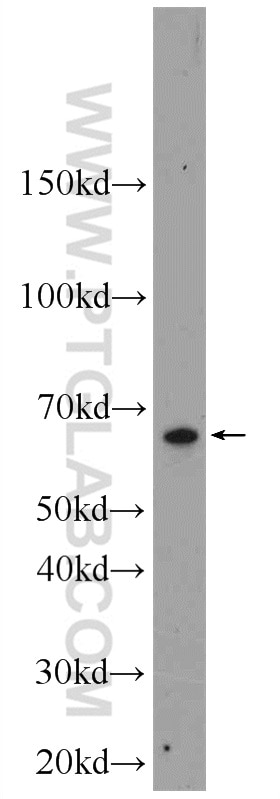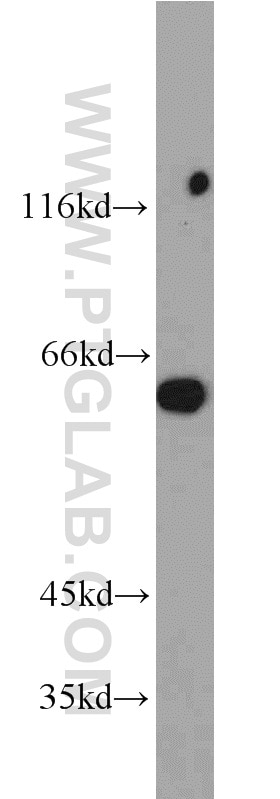- Phare
- Validé par KD/KO
Anticorps Polyclonal de lapin anti-L-Plastin
L-Plastin Polyclonal Antibody for WB, IHC, IP, ELISA
Hôte / Isotype
Lapin / IgG
Réactivité testée
Humain, rat, souris et plus (3)
Applications
WB, IHC, IF, IP, ELISA
Conjugaison
Non conjugué
N° de cat : 13025-1-AP
Synonymes
Galerie de données de validation
Applications testées
| Résultats positifs en WB | cellules Jurkat, cellules K-562, tissu splénique de souris |
| Résultats positifs en IP | cellules Jurkat |
| Résultats positifs en IHC | tissu de lymphome humain, tissu d'intestin grêle humain il est suggéré de démasquer l'antigène avec un tampon de TE buffer pH 9.0; (*) À défaut, 'le démasquage de l'antigène peut être 'effectué avec un tampon citrate pH 6,0. |
Dilution recommandée
| Application | Dilution |
|---|---|
| Western Blot (WB) | WB : 1:500-1:2000 |
| Immunoprécipitation (IP) | IP : 0.5-4.0 ug for 1.0-3.0 mg of total protein lysate |
| Immunohistochimie (IHC) | IHC : 1:20-1:200 |
| It is recommended that this reagent should be titrated in each testing system to obtain optimal results. | |
| Sample-dependent, check data in validation data gallery | |
Applications publiées
| KD/KO | See 1 publications below |
| WB | See 6 publications below |
| IHC | See 4 publications below |
| IF | See 1 publications below |
Informations sur le produit
13025-1-AP cible L-Plastin dans les applications de WB, IHC, IF, IP, ELISA et montre une réactivité avec des échantillons Humain, rat, souris
| Réactivité | Humain, rat, souris |
| Réactivité citée | Humain, poisson-zèbre, singe, souris, Hamster |
| Hôte / Isotype | Lapin / IgG |
| Clonalité | Polyclonal |
| Type | Anticorps |
| Immunogène | L-Plastin Protéine recombinante Ag3571 |
| Nom complet | lymphocyte cytosolic protein 1 (L-plastin) |
| Masse moléculaire calculée | 627 aa, 64 kDa |
| Poids moléculaire observé | 64-70 kDa |
| Numéro d’acquisition GenBank | BC010271 |
| Symbole du gène | L-Plastin |
| Identification du gène (NCBI) | 3936 |
| Conjugaison | Non conjugué |
| Forme | Liquide |
| Méthode de purification | Purification par affinité contre l'antigène |
| Tampon de stockage | PBS with 0.02% sodium azide and 50% glycerol |
| Conditions de stockage | Stocker à -20°C. Stable pendant un an après l'expédition. L'aliquotage n'est pas nécessaire pour le stockage à -20oC Les 20ul contiennent 0,1% de BSA. |
Informations générales
LCP1, also known as L-Plastin, is a member of the Plastin gene family. The family members include L-Plastin (LCP1), T-Plastin (PLS3), and I-Plastin (PLS1), which can regulate the dynamic reorganization of the cytoskeleton by binding and cross-linking actin filaments. In lymphocytes, LCP1 can regulate immune responses, especially during inflammation and infection. It acts as a key regulator of T-cell activation by responding to co-stimulatory signals through TCR/CD3 and CD2 or CD28, and regulates the cell-surface expression of IL2RA/CD25 and CD69 (PMID: 17294403).
Protocole
| Product Specific Protocols | |
|---|---|
| WB protocol for L-Plastin antibody 13025-1-AP | Download protocol |
| IHC protocol for L-Plastin antibody 13025-1-AP | Download protocol |
| IP protocol for L-Plastin antibody 13025-1-AP | Download protocol |
| Standard Protocols | |
|---|---|
| Click here to view our Standard Protocols |
Publications
| Species | Application | Title |
|---|---|---|
Sci Signal A hepatokine derived from the ER protein CREBH promotes triglyceride metabolism by stimulating lipoprotein lipase activity | ||
Mol Ther Nucleic Acids Exosomal Transfer of LCP1 Promotes Osteosarcoma Cell Tumorigenesis and Metastasis by Activating the JAK2/STAT3 Signaling Pathway. | ||
J Cell Sci Iterative Bleaching Extends Multiplexity (IBEX) facilitates simultaneous identification of all major retinal cell types | ||
Cancer Biomark LCP1 is a prognostic biomarker correlated with immune infiltrates in gastric cancer | ||
Drug Dev Res Therapeutic role of Artemether in the prevention of hepatic steatosis through miR-34a-5p/PPARα pathway | ||








